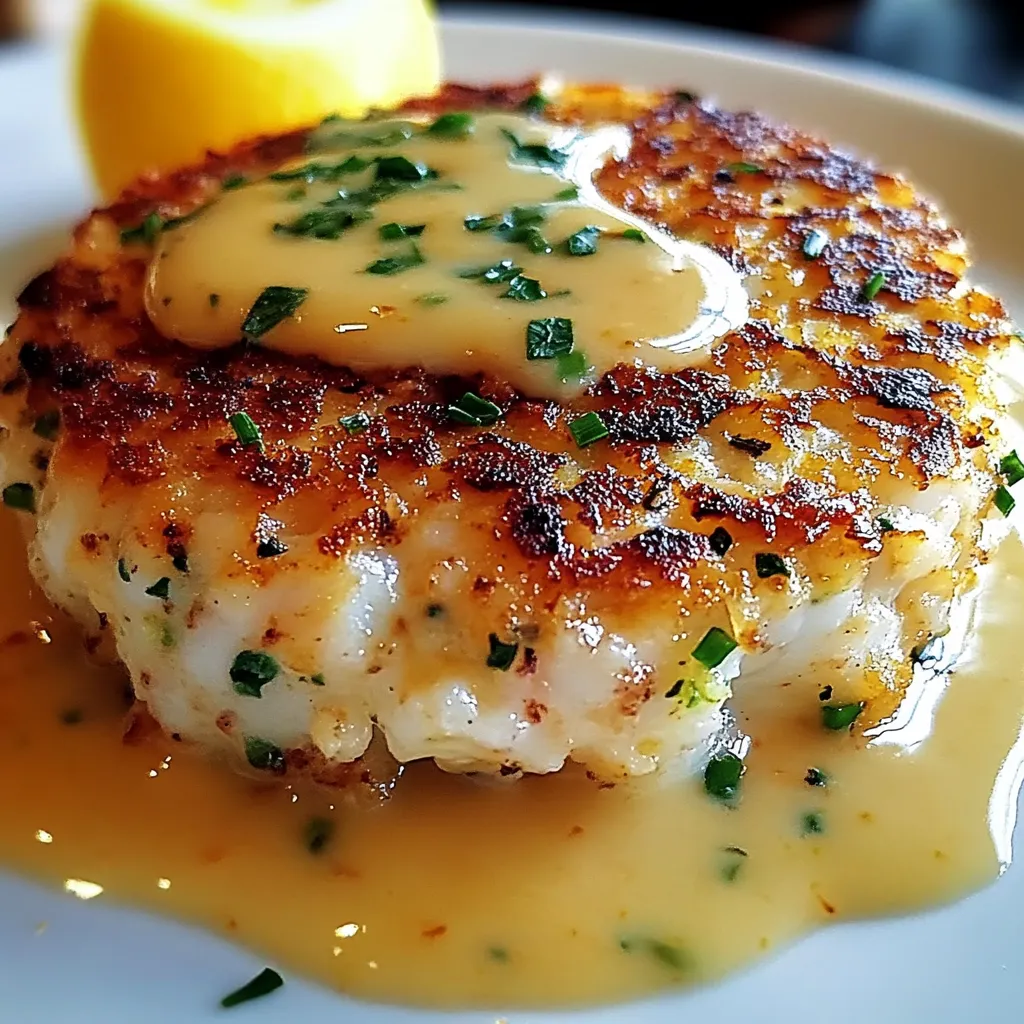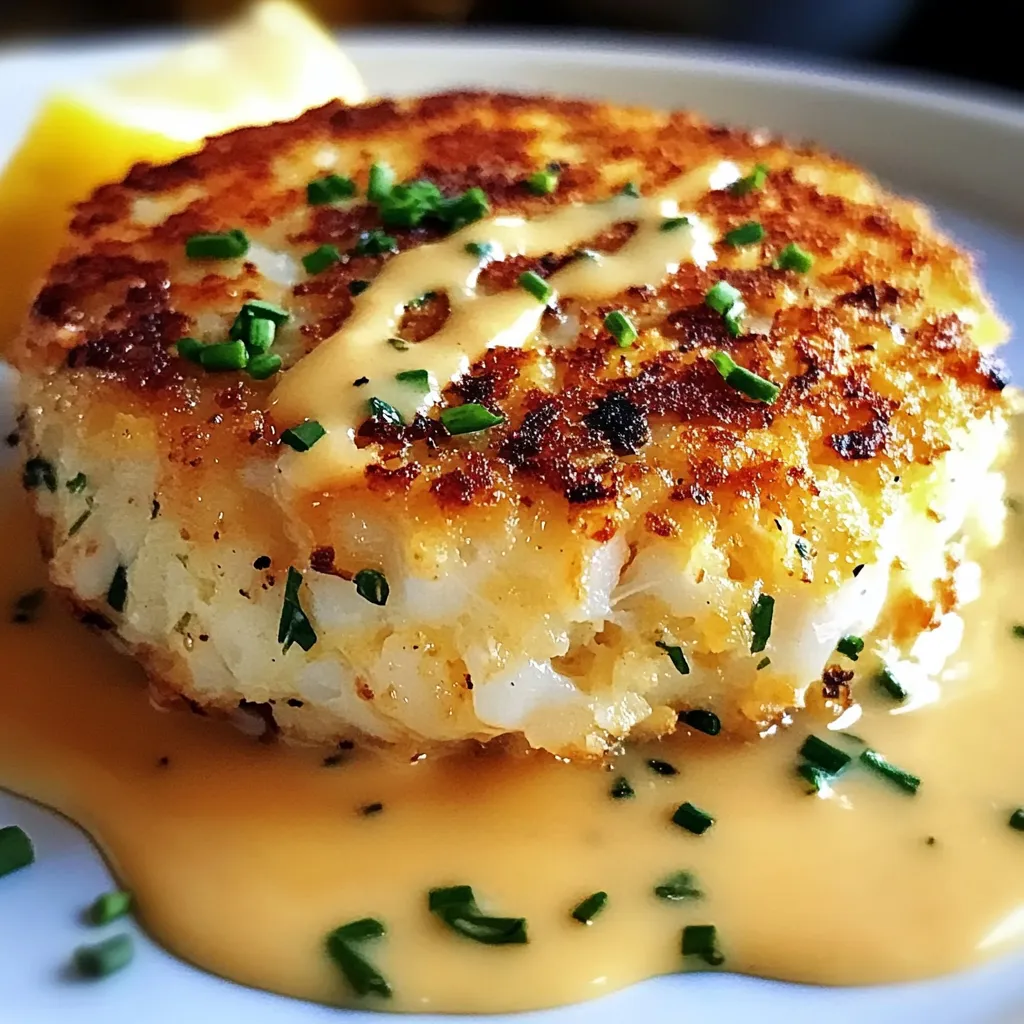 Save
Save
Cheddar bay crab cakes combine the sweet delicate flavor of fresh crab with the savory, cheese-infused essence of everyone's favorite seafood restaurant biscuits. Each golden-brown cake delivers crisp edges surrounding a tender interior studded with chunks of premium crab and infused with sharp cheddar. The finishing touch — a silky lemon butter drizzle — adds brightness that cuts through the richness while enhancing the natural sweetness of the crab. I created this recipe after craving both crab cakes and those addictive cheddar biscuits during the same meal and wondered what would happen if I merged these beloved favorites. The result was even more delicious than I imagined.
I first served these at a coastal-themed dinner party, and my brother-in-law, who typically avoids seafood, took a reluctant bite before immediately reaching for seconds. The familiar comfort of the cheesy biscuit flavor made the crab more approachable, while seafood enthusiasts appreciated the innovative twist on a classic. There's something magical about how the sharp cheddar enhances rather than overpowers the delicate crab, creating a perfect harmony of flavors that feels both familiar and exciting.
Fresh Ingredients
- Lump Crab Meat: Provides the sweet, delicate foundation of these cakes. Always use fresh, hand-picked crab when possible, carefully checking for shell fragments.
- Cheddar Bay Biscuit Mix: Creates the distinctive savory-cheesy flavor profile while helping bind the cakes. The dried garlic and cheddar in the mix infuse every bite.
- Fresh Parsley: Adds bright, herbaceous notes that complement the richness of the other ingredients. Always use flat-leaf Italian parsley for the strongest flavor.
- Old Bay Seasoning: Provides classic seafood seasoning with its blend of paprika, celery salt, and other spices. This iconic spice mix is non-negotiable for authentic flavor.
- Dijon Mustard: Contributes tangy depth that enhances the crab without overwhelming it. Use authentic Dijon rather than yellow mustard for proper flavor balance.
- Fresh Lemon: Essential for both juice and zest in the drizzle, providing aromatic citrus oils and bright acidity that cuts through richness. Always use fresh, never bottled.
- Quality Butter: Creates the foundation for the luxurious drizzle while adding richness to the cakes themselves. European-style butter with higher fat content produces superior results.
Cooking Process
- Prepare Perfect Crab Mixture:
- Begin by examining your crab meat carefully, spreading it on a plate and meticulously removing any shell fragments or cartilage—even small pieces can ruin the experience of these delicate cakes. Place the cleaned crab in a large mixing bowl, being careful to keep some larger lumps intact for textural contrast. In a separate bowl, combine the Cheddar Bay biscuit mix, mayonnaise, lightly beaten egg, and seasonings, stirring until well incorporated. This creates a binding mixture that will hold your crab cakes together while infusing them with flavor. Gradually fold this mixture into the crab meat using a rubber spatula with a gentle lifting motion rather than stirring, which would break up those precious lumps of crab. The goal is to distribute the binding ingredients evenly while maintaining the integrity of the crab pieces. The mixture should hold together when pressed but still showcase distinct pieces of crab throughout.
- Shape With Care:
- Using a 1/3-cup measuring cup, portion the mixture to ensure uniformly sized cakes that will cook evenly. Gently transfer each portion to a parchment-lined baking sheet, then use slightly moistened hands to shape them into patties about 3/4-inch thick. The moisture on your hands prevents sticking while allowing you to create cakes with clean edges. Press each cake firmly enough to help it hold together but not so firmly that you compress the delicate crab. If you notice the mixture sticking to your hands, simply re-moisten them with cold water. Once formed, create a slight dimple in the center of each patty with your thumb—this prevents the cakes from doming during cooking. Transfer the formed cakes to the refrigerator for at least 30 minutes, which allows the binding ingredients to set and helps the cakes maintain their shape during cooking.
- Master Perfect Cooking:
- Heat a heavy-bottomed skillet over medium heat until hot but not smoking. Add equal parts butter and olive oil—the butter provides rich flavor while the oil prevents burning. When the butter begins to foam, carefully add the chilled crab cakes, being careful not to overcrowd the pan. Cook in batches if necessary, as overcrowding causes steaming rather than proper browning. Allow the cakes to cook undisturbed for 3-4 minutes until the bottom develops a deep golden crust. Using a thin fish spatula, carefully flip each cake once, then continue cooking for another 3 minutes until both sides are beautifully browned and the interior reaches an internal temperature of 145°F. Transfer the cooked cakes to a paper-towel-lined plate to absorb any excess oil while maintaining their crisp exterior.
- Create Luscious Drizzle:
- While the cakes rest, prepare the lemon butter drizzle that elevates this dish from excellent to extraordinary. In a small saucepan over medium-low heat, melt fresh butter until it begins to foam but not brown. Remove from heat and whisk in fresh lemon juice and finely grated lemon zest, which adds aromatic oils essential for bright flavor. Season with a pinch of salt and freshly ground black pepper, tasting and adjusting as needed. The drizzle should be light enough to pour but thick enough to cling to the cakes. To serve, arrange the crab cakes on warmed plates, then spoon the lemon butter drizzle generously over each cake, allowing it to pool slightly around the base. Garnish with additional finely chopped parsley and a small wedge of lemon for both visual appeal and an extra burst of freshness if desired.
 Save
Save
I learned the importance of proper chilling after my first attempt resulted in cakes that fell apart during cooking. A chef friend explained that the refrigeration step isn't just for convenience—it's essential for allowing the proteins and binding agents to set properly. My family particularly enjoys these cakes for special celebrations or when visitors come to town. My husband, who grew up in Maryland and considers himself a crab cake purist, initially scoffed at the idea of adding Cheddar Bay flavoring but now requests these regularly over traditional versions. The way the cheese enhances the natural sweetness of the crab creates something truly special.
Perfect Pairings
These versatile crab cakes shine alongside various accompaniments. For an elegant dinner, serve atop a small bed of simply dressed arugula, allowing the peppery greens to cut through the richness while adding visual contrast. The lemon butter drizzle serves as both sauce for the crab cakes and dressing for the greens, creating a cohesive plate.
For a more substantial meal, pair with roasted asparagus and fingerling potatoes seasoned simply with olive oil, salt, and pepper. The clean flavors of these sides complement rather than compete with the star of the show. When serving as an appetizer, place a single cake on a small pool of the lemon butter drizzle and garnish with microgreens for an impressive restaurant-quality presentation.
Fresh Variations
Spicy Southwest: Transform these cakes with Tex-Mex flair by adding diced jalapeños, cilantro instead of parsley, and a pinch of cumin to the cake mixture. Replace the lemon butter drizzle with a smoky chipotle-lime sauce made by blending softened butter with adobo sauce, lime juice, and zest. This variation pairs beautifully with a cold Mexican beer or margarita for a festive meal.
Mediterranean Twist: Create an elegant variation by incorporating finely chopped sun-dried tomatoes and fresh basil into the crab mixture. Replace the lemon butter with a basil-infused olive oil drizzle, made by gently warming extra virgin olive oil with fresh basil leaves until fragrant, then straining. Serve alongside a simple tomato and cucumber salad dressed with red wine vinegar for a light summer meal.
New England Style: Adapt these cakes for a New England flavor profile by adding finely diced fennel bulb to the mixture and substituting fresh dill for parsley. Create a tarragon-lemon butter for drizzling and serve with a side of simple coleslaw dressed with vinegar rather than mayonnaise. This variation evokes coastal summer dining and pairs wonderfully with a crisp Sauvignon Blanc.
Freshness Tips
Storage Strategy: Store uncooked crab cake mixture in an airtight container for up to 24 hours before shaping and cooking. For cooked cakes, refrigerate in a single layer in a covered container for up to two days. Separate layers with parchment paper to maintain their shape and prevent sticking.
Reheating Method: For the best texture when reheating, place refrigerated crab cakes on a baking sheet in a 325°F oven for about 10 minutes until warmed through. Avoid microwave reheating, which creates a soggy texture and rubbery crab. Prepare fresh lemon butter drizzle just before serving reheated cakes for the brightest flavor.
Freezing Strategy: While best enjoyed fresh, uncooked crab cakes can be frozen for up to one month. Place shaped, uncooked cakes on a parchment-lined baking sheet and freeze until solid, then transfer to an airtight container with parchment between layers. Thaw overnight in the refrigerator before cooking according to the original instructions, adding an extra minute per side to ensure they're heated through.
 Save
Save
These cheddar bay crab cakes have earned a special place in my recipe collection for how they transform an already beloved dish into something even more memorable. What I appreciate most is their ability to please both seafood enthusiasts and those who might normally shy away from crab. The familiar, comforting flavor of the cheddar bay elements creates an approachable entry point, while the quality crab and thoughtful preparation satisfy even the most discerning palates. Whether served as an impressive dinner party starter or the star of a special family meal, these cakes consistently earn rave reviews and recipe requests. Sometimes the best culinary innovations come from combining favorites in unexpected ways, and these crab cakes are delicious proof of that principle.
Common Questions About Cooking
- → Can I make these crab cakes ahead of time?
- Yes! You can form the patties up to 24 hours in advance and keep them covered in the refrigerator. This actually helps them hold together better when cooking. The lemon butter sauce is best made fresh just before serving.
- → What can I use instead of Cheddar Bay Biscuit mix?
- If you can't find Cheddar Bay Biscuit mix, you can substitute 1/2 cup of panko breadcrumbs mixed with 2 tablespoons of grated cheddar cheese and 1/4 teaspoon of garlic powder. This will create a similar flavor profile.
- → What's the best type of crab meat to use?
- Lump or jumbo lump crab meat works best because it has large chunks that give the crab cakes a luxurious texture. Avoid using claw meat or imitation crab, as they won't provide the same flavor or texture.
- → How do I prevent my crab cakes from falling apart?
- Make sure to refrigerate the formed patties for at least 20 minutes before cooking. This helps them firm up. Also, handle them gently when flipping, and make sure your pan and oil are hot before adding the crab cakes to create a quick sear.
- → What can I serve with these crab cakes?
- These crab cakes pair wonderfully with a fresh green salad, roasted asparagus, or corn on the cob. They also make great appetizers when made smaller, or can be served on brioche buns as sandwiches with lettuce, tomato, and a dollop of remoulade sauce.
